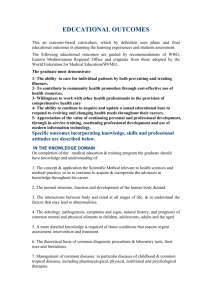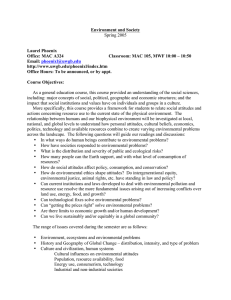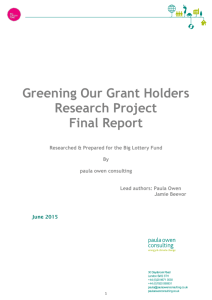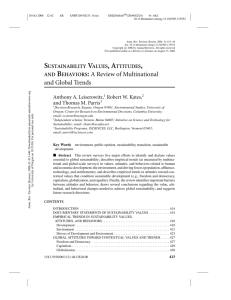today - Teaching Heritage
advertisement
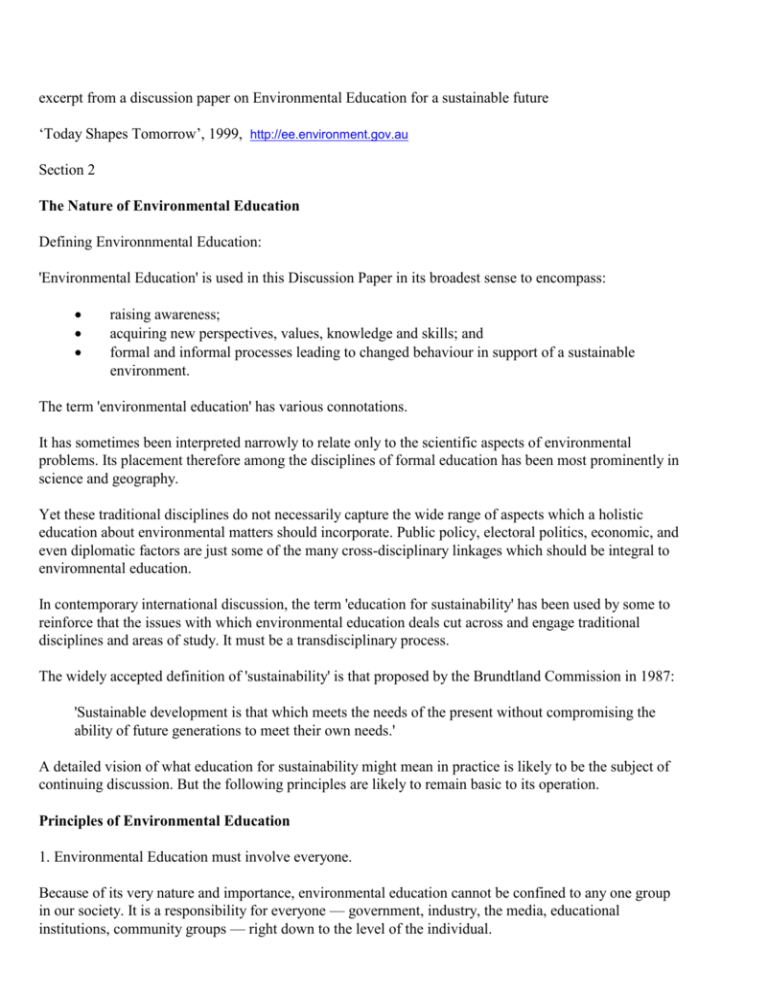
excerpt from a discussion paper on Environmental Education for a sustainable future ‘Today Shapes Tomorrow’, 1999, http://ee.environment.gov.au Section 2 The Nature of Environmental Education Defining Environnmental Education: 'Environmental Education' is used in this Discussion Paper in its broadest sense to encompass: raising awareness; acquiring new perspectives, values, knowledge and skills; and formal and informal processes leading to changed behaviour in support of a sustainable environment. The term 'environmental education' has various connotations. It has sometimes been interpreted narrowly to relate only to the scientific aspects of environmental problems. Its placement therefore among the disciplines of formal education has been most prominently in science and geography. Yet these traditional disciplines do not necessarily capture the wide range of aspects which a holistic education about environmental matters should incorporate. Public policy, electoral politics, economic, and even diplomatic factors are just some of the many cross-disciplinary linkages which should be integral to enviromnental education. In contemporary international discussion, the term 'education for sustainability' has been used by some to reinforce that the issues with which environmental education deals cut across and engage traditional disciplines and areas of study. It must be a transdisciplinary process. The widely accepted definition of 'sustainability' is that proposed by the Brundtland Commission in 1987: 'Sustainable development is that which meets the needs of the present without compromising the ability of future generations to meet their own needs.' A detailed vision of what education for sustainability might mean in practice is likely to be the subject of continuing discussion. But the following principles are likely to remain basic to its operation. Principles of Environmental Education 1. Environmental Education must involve everyone. Because of its very nature and importance, environmental education cannot be confined to any one group in our society. It is a responsibility for everyone — government, industry, the media, educational institutions, community groups — right down to the level of the individual. 2. Environmental Education must be lifelong. Information about environmental problems is forever improving, as we learn from our past experiences and mistakes. As we develop and apply better environmental technologies, the ability of society and individuals to respond effectively also improves. In order to move closer to achieving sustainable development as a nation, all Australians need to continually refresh the knowledge and skills which they apply to the environmental challenges we face. Just as workplace learning and retraining are essential to continued productivity, the same is true of environmental education, whether in formal or non formal settings. 3. Environmental Education must be holistic and about connections. In order to address environmental challenges, we need people who think broadly and who understand systems, connections, patterns and causes. The challenges themselves frequently have social, scientific, cultural, economic and ethical aspects, all of which must be considered for their effective management. Specialist discipline-based knowledge, while contributing critically, is no longer adequate by itself holistic appreciation of the context of environmental problems is essential. Meeting this need presents a dilemma to the formal education systems over whether environmental education should be taught as a separate subject or incorporated into one or more particular subject areas. The right answer may vary from situation to situation, depending on what is most practical — suffice to say, a much stronger re-orientation of all relevant areas of formal education towards issues of sustainability is required. Equally important is the need to establish better communicative links between those people working on, or learning about, similar or related environmental issues, but who come from different professional or disciplinary backgrounds. Better grounds for communication and partnerships are also required between formal and non formal education settings, and between various groups with competing interests on environmental issues. 4. Environmental Education must be practical. One of the most fundamental defining characteristics of effective environmental education is that it must lead to actions which result in better environmental outcomes, not simply the accumulation of inert knowledge or impractical skills. This is ultimately the yardstick by which we are able to measure the effectiveness of our efforts in environmental education. 5. Environmental Education must be in harmony with social and economic goals: Effective environmental education must also encourage the pursuit of environmental goals in harmony with other powerful and legitimate social and economic goals — it should not be taught in a vacuum, or simply equip people to pursue an agenda on the margins of society. Environmental education needs to incorporate this reality by providing people with the knowledge, understanding and capacity to influence mainstream society in a way which progresses environmental objectives along with other legitimate social and economic objectives. The Components of Environmental Education The evolution of environmental education has required closer and renewed investigation into learning processes. It has become customary to define the components of learning relevant to environmental sustainability. These are sometimes described, misleadingly, as'stages'. Even though they may seem to follow a natural sequence and be discrete in themselves, people's encounter with issues of sustainability can begin and develop from any of these components. They should be seen as cyclical and interactive, with periods focused on reflection, research, development and action. These components, which apply equally to formal and informal education, are adapted from the international edition of 'Teaching for a Sustainable World', edited by John Fien, 1996 (Introduction xxvi-xxvii). Awareness raising — 'Does it matter to me?' Market research into environmental issues consistently confirms what educators have long held as a first principle of operation: start from where the students (or consumers, farmers, industrialists, citizens, decision makers and so on) are. What is it that matters to them most at this point in time? What do they want to achieve? How do these attitudes relate to environmental issues? These are the starting points for any useful process of problem solving as well as meaningful and enduring learning. Awareness raising is not just a matter of shaping attitudes; it must also be about the development of knowledge. Is this view legitimate? What information supports it'? Is that information relevant and reliable? It is anticipated that from these initial steps of establishing and confirming the personal relevance of environmental issues, there will be an evolution to understanding of issues on a larger scale: personal, local, regional, national and global. Shaping of values — 'Should I do something about it?' Without appropriate and helpful underlying values and attitudes, environmental education is bound for failure. These values include: respect for and appreciation of the interdependence of all life forms and the resilience, fragility and aesthetic qualities of the natural environment appreciation of the dependence of human life on the finite resources of the earth appreciation of the role of human ingenuity and creativity in ensuring survival and in the search for appropriate and sustainable progress Because of the way in which environmental education may challenge accepted practices and beliefs, it is an area of some contestation. For this reason the process of developing values has a controversial aspect. Thus the following values are also most important: a sense of balance and fairness to all in deciding among conflicting priorities an appreciation of the importance and value of individual responsibility and action. Developing knowledge and skills — 'How can I do something about it?' At its heart capacity building means acquiring relevant knowledge and skills, a process often seen as the conventional function of any type of education. It has been noted that the types of knowledge needed to participate effectively in environmental education are wide ranging and not confined to any particular discipline. Some of the areas of knowledge which environmental education must deal with however are: the planet earth as a finite system the resources of the earth, particularly air, soil, water, minerals, their distribution and their role in supporting living organisms the nature of ecosystems, their health and interdependence within the biosphere the dependence of humans on the environmental resources for life and sustenance sustainable relationships within the environment the implications of resource distribution in determining the nature of societies and the rate and character of economic development the role and values of science and technology in the development of societies and the impact of technologies on the environment the interconnectedness of present political, economic, environmental and social issues, and processes of planning, policy-making and acting to solve problems. The skills which should be acquired include capacities to: define and explain fundamental concepts such as environment, ecological systems, community, development and technology and being able to apply them to specific situations using a range of relevant resources and technologies analyse problems, and frame and investigate relevant questions assess and evaluate differing points of view develop hypotheses based on balanced and accurate information, engage in critical analysis and careful synthesis, and test new information and personal beliefs, explorations and experiences against these hypotheses communicate information and points of view effectively develop partnerships and the foundation for cooperative and consensual action develop strategies for action, including locating appropriate resources, and means for their implementation. Making decisions and taking action — 'What will I do?' Environmental education is not a passive process. In response to the new levels of awareness, knowledge and skill, and on the basis of evolving values and attitudes (all suggested above), it is about changing behaviour, whether one's own or as part of larger community changes. As mentioned above, this is one of environmental education's defining characteristics. It is, above all, practical in the sense that some result should and must come from it if our futures are to be as we would wish. The Evolution of Environmental Education A model developed in the Netherlands (Caring for the Earth: A Strategy for sustainable living IUCN,UNEP, WWF l991) suggests a series of stages in the evolution of environmental education. The four stages suggested are: 1. Reactive: providing particular products and programs in response to limited demand. Education is often instigated by isolated individuals, specialists, voluntary organisations, or the information/community relations/education units of some government agencies. Education aims at reducing ecological ignorance. 2. Receptive: in which organisations include environmental education objectives in their policies and planning. School curriculum development bodies become involved, but programs are implemented without reference to work elsewhere in the education field. Objectives emphasise changing knowledge and attitudes. 3. Constructive: in which programs and objectives are more thoroughly implemented. There is wide dissemination of developments, links are made across sectors. There is community participation and objectives are oriented towards sustainable living. 4. Pro-active: in which the culture of all organisations is defined in terms of ecologically sustainable living supported by comprehensive, lifelong environmental learning integrated within education systems, industry, social organisations/neighbourhood groups and government. It can be argued that environmental education in Australia is generally in the second stage described by this model with some evidence of progress towards the third. Further substantial action is required to take us towards the fourth stage. Reproduced with the permission of Environment Australia.


